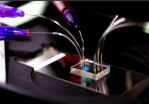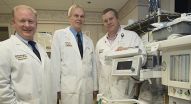(Press-News.org) A team of Massachusetts General Hospital (MGH) investigators has identified what may be a biomarker predicting the development of the dangerous systemic infection sepsis in patients with serious burns. In their report in the open-access journal PLOS ONE, the researchers describe finding that the motion through a microfluidic device of the white blood cells called neutrophils is significantly altered two to three days before sepsis develops, a finding that may provide a critically needed method for early diagnosis.
"Neutrophils are the major white blood cell protecting us against infection, and a healthy individual has an army of 25 billion circulating neutrophils ready to fight invading pathogens," explains Daniel Irimia, MD, PhD, associate director of the BioMEMS Resource Center in the MGH Department of Surgery and corresponding author of the PLOS ONE report. "The most common blood test ordered to evaluate a patient's ability to fight infection is absolute neutrophil count, based on the assumption that - like well-trained soldiers - neutrophils are always fast, disciplined and effective in pursuing their targets, meaning that the size of the neutrophil 'army' is all that matters. Our work challenges that assumption and shows that, even when the number of neutrophils is unchanged, the army can fall into disarray and become ineffective."
Sepsis is the leading cause of death among patients with major burns - those affecting more than 20 percent of body surface - with a mortality rate of 30 percent. It has been calculated that every 6 hours of delay in a sepsis diagnosis decreases the chances of survival by 10 percent. Since the symptoms of sepsis are similar to those of the systemic inflammation that occurs in almost every serious burn patient, diagnosing sepsis relies on culturing bacteria from the blood, a process that takes 12 to 24 hours.
While no previous studies had identified sepsis-associated changes in the motion of neutrophils - which travel to sites of infection in response to chemical signals - the motility or ability to move spontaneously of neutrophils is known to be less efficient in burn patients than in healthy individuals, leading the researchers to wonder whether correlations might exist between changes in neutrophil motility and sepsis in patients with major burns.
To investigate this possibility, the MGH team designed a microfluidic device with channels smaller than the diameter of neutrophils to study the cells' motion toward a chemical signal. Straight channel sections measured the speed and persistence of the cells' motion, and divisions and obstacles in the channels tested the cells' ability to change directions. The researchers then analyzed the ability of neutrophils from blood samples of 13 patients with serious burns, collected several times during their treatment, to move through the device when it was primed with one of two chemical attractants or with saline solution, and compared it with the movement of cells from 3 healthy volunteers.
Neutrophils from healthy individuals moved quickly and efficiently through the device toward a chemical attractant - easily navigating around corners and posts - while cells from burn patients showed limited, slower and poorly organized movement toward the chemical signal. But analyzing movement patterns when the device contained no chemical attractant revealed a surprising finding: neutrophils from patients who had developed or were about to develop sepsis spontaneously moved through the device - like soldiers deciding to advance in the absence of any orders - while those from other patients and from healthy volunteers showed little or no motion.
This movement of neutrophils in the absence of chemical signals was observed in samples taken from some patients several days before a diagnosis of sepsis could be made, and once effective antibiotic treatment began, the unusual movement pattern began to fade. The authors note that, in addition to allowing faster initiation of antibiotic treatment, the ability to diagnose sepsis rapidly and accurately would reduce the inappropriate use of antibiotics that leads to the proliferation of resistant bacteria that is so common in burn units.
"Since only a handful of rare genetic disorders affect neutrophil function, it has long been assumed that studying these cells was not important; but our findings indicate that neutrophils play a much more important role in sepsis than has been appreciated," says Irimia, an assistant professor of Surgery at Harvard Medical School. "Studies including larger numbers of patients with major burns and more precise measurements are under way. We're also working to expand this investigation to other patients at risk for sepsis, to see if the findings from burn patients have broader application."
INFORMATION:
Caroline Jones, PhD, of the BioMEMS Resource Center in the MGH Department of Surgery, is lead author of the PLOS ONE paper. Additional co-authors are Molly Moore, Laurie Dimisko, Andrew Alexander, Amir Ibrahim, Bryan Hassell, Ronald Tompkins, ScD, MD, and Shawn Fagan, MD, MGH Surgery; and H. Shaw Warren, MD, MGH Department of Pediatrics. Support for the study includes National Institutes of Health grants GM092804, EB002503 and GM007035. Several patents relating to the technology in the device described in this paper have been issued or applied for.
Massachusetts General Hospital, founded in 1811, is the original and largest teaching hospital of Harvard Medical School. The MGH conducts the largest hospital-based research program in the United States, with an annual research budget of more than $785 million and major research centers in AIDS, cardiovascular research, cancer, computational and integrative biology, cutaneous biology, human genetics, medical imaging, neurodegenerative disorders, regenerative medicine, reproductive biology, systems biology, transplantation biology and photomedicine.
Timing is key for brain cells controlling a complex motor activity like the singing of a bird, finds a new study published by PLOS Biology.
"You can learn much more about what a bird is singing by looking at the timing of neurons firing in its brain than by looking at the rate that they fire," says Sam Sober, a biologist at Emory University whose lab led the study. "Just a millisecond difference in the timing of a neuron's activity makes a difference in the sound that comes out of the bird's beak."
The findings are the first to suggest that fine-scale timing of neurons ...
Researchers from the University of Cambridge have used genome sequencing to monitor how the spread of methicillin-resistant Staphylococcus aureus (MRSA) occurs in under-resourced hospitals. By pinpointing how and when MRSA was transmitted over a three-month period at a hospital in northeast Thailand, the researchers are hoping their results will support evidence-based policies around infection control.
MRSA is a common cause of hospital-acquired infections, with the largest burden of infections occurring in under-resourced hospitals in the developing world. Whereas genome ...
The availability of a trace nutrient can cause genome-wide changes to how organisms encode proteins, report scientists from the University of Chicago in PLoS Biology on Dec. 9. The use of the nutrient - which is produced by bacteria and absorbed in the gut - appears to boost the speed and accuracy of protein production in specific ways.
"This is in some sense a 'you are what you eat' hypothesis,"' said senior study author D. Allan Drummond, PhD, assistant professor of biochemistry and molecular biology at the University of Chicago. "This nutrient that is absorbed through ...
AUDIO:
Nitrous oxide, often called laughing gas, has been used in medicine and in dentistry for more than 150 years. But researchers at Washington University School of Medicine in St. Louis...
Click here for more information.
Nitrous oxide, or laughing gas, has shown early promise as a potential treatment for severe depression in patients whose symptoms don't respond to standard therapies. The pilot study, at Washington University School of Medicine in St. Louis, is believed to ...
A new policy paper by a University of York academic calls for limits on the influence of the drinks industry in shaping alcohol policy because it has a 'fundamental conflict of interest'.
The article by Professor Jim McCambridge, of the Department of Health Sciences at York and academics at King's College London and the University of Newcastle, New South Wales, is published in this week's PLOS Medicine.
It says the concept of harm reduction has been co-opted by industry interests in public health debates about reducing the damage caused by alcohol. The paper argues ...
Is being located next to a big-name competitor always bad for your small business? A new study in the Journal of Marketing Research shows that contrary to accepted belief, the presence of a large, nearby competitor can actually boost the sales of smaller brands.
"When the owner of Los Angeles's Coffee Bean & Tea Leaf could not stop Starbucks from moving in next door, he at first admitted defeat," note authors Neeru Paharia (Georgetown University), Jill Avery (Harvard University), and Anat Keinan (Harvard University). "However, soon after, he was surprised to see his sales ...
LOS ANGELES (Dec. 09, 2014) - A computer system was more effective than doctors at collecting information about patient symptoms, producing reports that were more complete, organized and useful than narratives generated by physicians during office visits, according to a Cedars-Sinai study.
Investigators said the research, published in the American Journal of Gastroenterology, highlights the potential of computers to enhance the quality of medical care and improve outcomes by harnessing accurate and thorough patient information.
The authors said they did not expect ...
PROVIDENCE, R.I. [Brown University] -- Harmful bacteria have evolved some ingenious mechanisms to resist antibiotics. One of those is the drug efflux pump -- proteins that stand guard along bacterial cell membranes, identifying antibacterial agents that pass through the membrane and swiftly ejecting them from the cell.
"These drug efflux pumps are extremely problematic," said Jason Sello, associate professor of chemistry at Brown University. "The drugs are pumped out of the bacteria and cannot reach the critical concentration for toxicity."
Sello and a team of researchers ...
With Americans spending billions of dollars each year on nutritional supplements, researchers have analyzed popular eye vitamins to determine whether their formulations and claims are consistent with scientific findings. They determined that some of the top-selling products do not contain identical ingredient dosages to eye vitamin formulas proven effective in clinical trials. In addition, the study found that claims made on the products' promotional materials lack scientific evidence. The results of their study were published online in Ophthalmology, the journal of the ...
In results characterized as "very surprising," UCLA researchers found for the first time that higher-earning clinicians make more money by ordering more procedures and services per patient rather than by seeing more patients, which may not be in patients' best interest.
The research team from the UCLA Department of Urology and the Veterans' Health Administration examined what Medicare was billed and what it paid to clinicians. The data reviewed was Medicare Part B payments from the 2012 calendar year, said letter first author Dr. Jonathan Bergman, an assistant professor ...


